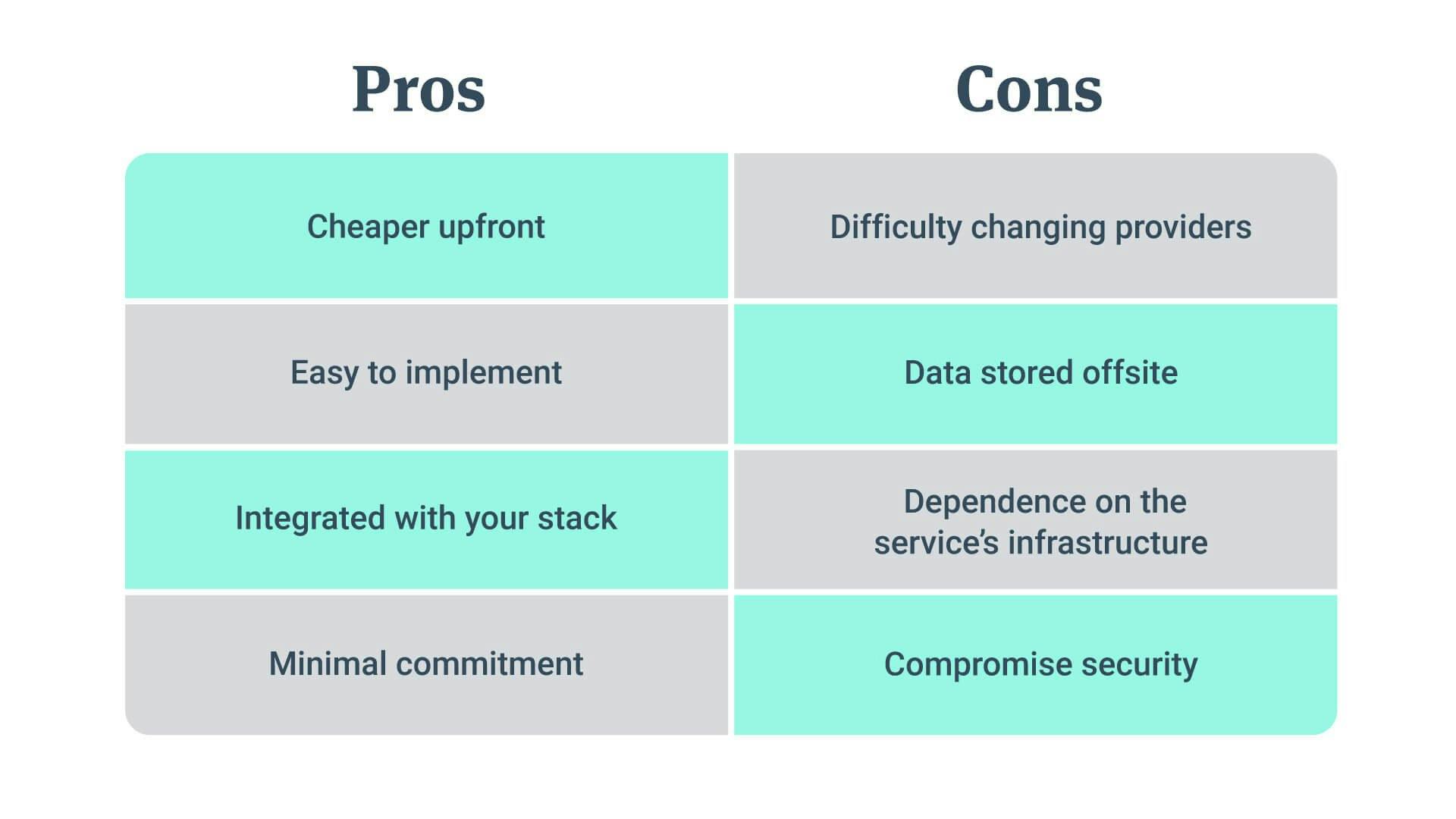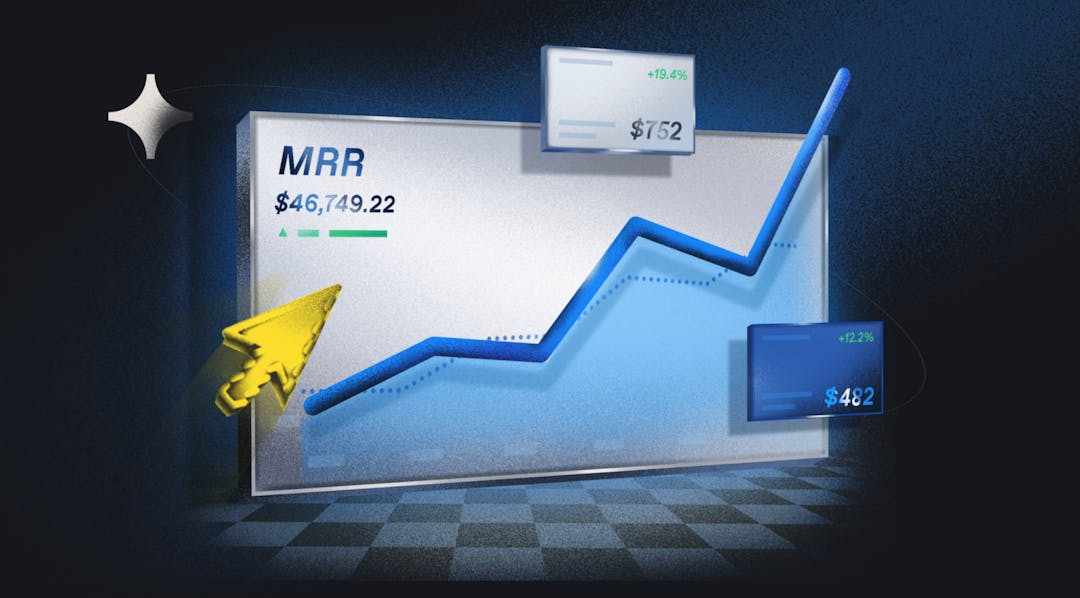SaaS has many advantages: it’s easy to adopt and low-cost upfront. But there can be disadvantages too. Is SaaS right for you?
The SaaS model continues to gain traction. It seems as though more and more companies are jumping on the cloud bandwagon…and for good reason. If you haven’t transitioned to SaaS yet, I promise moving to a cloud-based computing system sounds more complicated than it actually is. There are many different cloud-based models for storing data, but this article is focused directly on SaaS.
I’ll walk you through what SaaS is, how it compares to other cloud services, and the pros/cons of SaaS.

What is SaaS?
SaaS stands for “software as a service.” SaaS is when a provider hosts an application and makes it available to subscribers over the internet. Simply, any company that sells software via a central, cloud-based system can be considered SaaS. SaaS is typically a downloadable application that users can use as long as they have an internet connection.
SaaS vs. IaaS vs. PaaS vs. on-premise: What’s the difference?
There are two other cloud service models to be aware of: PaaS and IaaS. PaaS stands for ‘platform as a service,’ providing developers with a complete environment for developing and deploying apps over the internet. IaaS stands for ‘infrastructure as a service’ and provides the hardware to perform various tasks.
Some common examples of SaaS solutions are of course ProfitWell, SalesForce, Microsoft Office, Zoom, Dropbox—the list goes on.
Cloud infrastructure services, aka IaaS, are highly scalable and automated computer, network, and storage resources. IaaS is made up of a collection of physical and virtualized resources. Customers typically don’t interact with the physical data centers, but it is provided as a service to them. Google Compute Engine (GCE), Digital Ocean, and Amazon Web Services (AWS) are all good examples of IaaS.
Platform as a service, PaaS, is also a cloud computing but service providers deliver platforms to clients, allowing them to develop, run, and manage business applications without the need to build and maintain the infrastructure. PaaS’s delivery model is similar to SaaS, however instead of delivering the software over the internet, PaaS is a platform for software creation. Some PaaS examples include Windows Azure, Google App Engine, and Force.com.

4 benefits & advantages of choosing SaaS
Moving everything to the cloud, in general, has numerous benefits. For Saas, specifically, the benefits all boil down to cost and ease of use. Let’s get right into each direct benefit you’ll definitely appreciate once you transition to SaaS.
Cheaper upfront
Since SaaS is typically subscription-based (aka, no licensing fees) there are lower costs upfront. SaaS exists in the cloud, meaning hardware installation costs are completely eliminated. Without hardware—you don’t have to continuously pay for hardware maintenance. This makes SaaS advantageous for startups.
Easy to implement
SaaS is already installed and configured in a cloud, so you don’t have to worry about setting up the infrastructure (which can get complicated). Implementation typically only involves registering and either downloading a web browser extension or the application to your computer.
Adopting SaaS means you don’t have to build out your own infrastructure and software. Beyond the implementation stage, SaaS is easy for updates. SaaS providers manage hardware and software updates, leaving you with a more seamless experience.
Integrated with your stack
The SaaS model is extremely customizable as most SaaS applications are geared toward integrations. Take ProfitWell for example. We understand that you need additional software to maximize your business. We integrate with a variety of different platforms. With ProfitWell, you can easily use our products to manage your pricing while also managing your billing through a service like Stripe.
Minimal commitment
Annual contracts are the best in terms of reducing churn. However, the subscription model is flexible. Offering month-to-month payments makes customers feel more at ease signing on with your product, knowing they can back out if they are unhappy. Most SaaS companies also offer different plans that include various pricing options and service features. Having a wide variety of software allows customers to switch things up if need be.
4 potential downsides & disadvantages of SaaS
While I tend to think the pros outweigh the cons when it comes to SaaS, I’ll mention the cons regardless. The few points I’m about to break down are things to consider if you are planning on transitioning to SaaS.
Difficulty of changing providers
If your SaaS provider goes bust or you want to make a change, transferring your data may be difficult. Have the conversation with your SaaS provider in advance about how you can easily access data or transfer it in case you want to change plans or the provider goes south.
Storing your data offsite
Depending on how sensitive your data is, storing it offsite with a SaaS service may present problems with compliance. SaaS is definitely gaining fraction, but there are limited options because a lot of applications have yet to develop SaaS versions. Before purchasing a software subscription, research the capabilities you need and ensure they are present.
Dependence on the service’s infrastructure
With a SaaS product, you're dependent on their infrastructure and software: if it goes down, so do you. Most SaaS vendors do promise reliability, however you should still do your research on the reliability of a certain vendor before moving forward. You also need to decide if your company can handle the potential of an outage, that’s completely out of your control. I’m not saying an outage is definitely going to happen, but there is always the risk and you need to be aware that this could happen when using SaaS.
Compromised security
Security is the biggest concern for companies hesitant about transitioning to the SaaS model. Data is stored locally with conventional software, but with SaaS, your data is likely stored offsite by the vendor. You must rely on the vendor to properly secure and backup all of your data. Another security risk is when employees access the software on potentially insecure outside connections. This increases the risk for hackers and people stealing your information. To maximize security protection, research your vendor thoroughly. As for your employees, require them to enable two-factor authentication when using the software on their own computers.
Is your business ready for a SaaS model?
Not all businesses are meant to be a SaaS business, but if you have a great software, an existing customer base, and a recurring payment processor, you’re on your way there. When implemented correctly, SaaS is a better business model for not only clients but also software providers. It gives your customers an easy-to-use system while giving your business a simple way to upgrade your product and push those changes out to customers easily.
If you want to take your business to the next level and are ready to experience even more growth, transition to SaaS.



